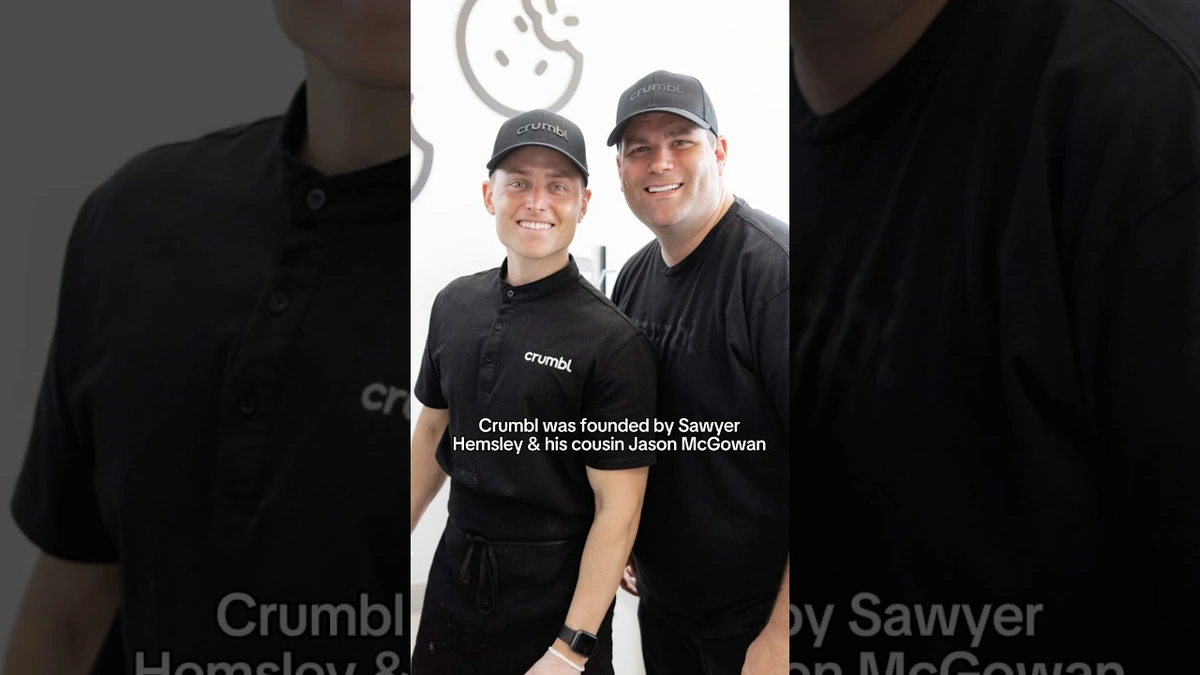Let’s be honest for a second. You’ve seen the box. That iconic, perfectly square, instantly recognizable pink box. Maybe it popped up on your Instagram feed, maybe it was the star of a TikTok “unboxing,” or maybe you’ve even carried one yourself, feeling a little bit like you were part of an exclusive club.
Inside, four or six gigantic, gourmet cookies sit nestled like jewels. This isn’t just a dessert; it’s an event. It’s a weekly ritual for millions. And the man behind it all, co-founder Sawyer Hemsley , is arguably one of the most interesting entrepreneurs of the last decade.
But here’s the thing that fascinates me. The question isn’t “How did a cookie company get so big?” The real question, the one we should be asking, is why this specific company, started in a small Utah town in 2017, exploded into a billion-dollar empire with over 900 stores, while countless other bakeries are still just… bakeries.
The answer isn’t just in the flour and sugar. It’s in the data, the calculated virality, and a business philosophy that treats a cookie less like a pastry and more like a tech product. Sawyer Hemsley didn’t just create a great cookie; he created a content machine that happens to be edible.
The “Tech Company That Sells Cookies” Philosophy

To understand Crumbl, you have to understand its origin story. Sawyer Hemsley , a young guy with a knack for branding and social media, teamed up with his cousin, Jason McGowan. Now, McGowan wasn’t a baker he was a tech guy, a veteran of the startup world. This detail is everything.
From day one, they didn’t operate like a traditional bakery. They operated like a Silicon Valley startup. The initial quest for the perfect chocolate chip cookie wasn’t just about taste-testing with friends. It was, in their own words, relentless A/B testing.
Think about that. A/B testing is something you do with website layouts or app buttons, not cookie recipes. They would bake two slightly different versions and then, famously, run out to gas stations and grocery store parking lots, asking random strangers to vote. “Which one do you like more? Why?” This wasn’t just a charming founder story; this was real-world, agile user-experience research.
This tech-first DNA is embedded in the entire Crumbl business model :
- The App: It’s slick, it’s easy to use, and it drives loyalty. It’s a data-gathering machine that tells them exactly what’s popular, where, and when.
- The In-Store Experience: The open-concept kitchen isn’t just for show. It’s about transparency and process. You see your “tech product” being assembled in real-time. It’s part of the brand experience.
- The Feedback Loop: They obsessively monitor social media comments and reviews, feeding that data directly back into recipe development and operations.
So, when you call Crumbl a bakery, you’re only seeing half the picture. It’s a ruthlessly efficient, data-driven logistics and tech company that just so happens to have a delicious, tangible output. The cookie is the hardware; the app and the marketing are the software. You might also want to read about the legacy of Candace Parker who also built an empire in her own right.
Cracking the TikTok Code | The Weekly Drop Is the Real Product

Okay, let’s talk about the masterstroke. The thing that turned Crumbl from a successful business into a cultural force: the weekly rotating menu.
This is pure, uncut marketing genius.
By changing the lineup every single Sunday night, Sawyer Hemsley and Jason McGowan injected a powerful drug into their business model: FOMO (Fear Of Missing Out). That incredible Churro or Key Lime Pie cookie you saw on Instagram? It’s gone next week. Maybe forever. You have to go now.
This strategy brilliantly transforms a simple purchase into a timely, must-have event. It’s a page straight out of the playbook of “drop culture,” typically associated with brands like Supreme or limited-edition sneaker releases from Nike. It manufactures scarcity and urgency.
And here’s why it’s so perfect for our current media landscape. The weekly drop is the engine of their incredible TikTok marketing machine. It provides a built-in, recurring reason for people to create content about the brand, every single week, for free. The “Crumbl Review” is a full-blown TikTok subgenre. Influencers and regular people alike race to post their “verdict” on the week’s flavors, generating millions of views and an avalanche of user-generated advertising that a traditional brand would have to pay a fortune for.
The pink box becomes a prop. The cookie becomes the star. The customer becomes the advertiser. It’s a perfect, self-sustaining viral loop. You’re not just buying a snack; you’re buying a piece of shareable content.
The Franchise Flywheel | How Explosive Growth Fueled Itself

A brilliant concept is one thing. Scaling it to nearly 1,000 locations in just over six years is another. This is where the franchise model comes in, but again, with a uniquely Crumbl twist.
They created a highly systematized, almost “plug-and-play” operation. Franchisees don’t have to be master bakers. The dough is often made in central commissaries and shipped to stores, ensuring rock-solid consistency. The tech is standardized. The marketing is handled by corporate. This lowers the barrier to entry (though the financial investment is steep) and makes the model replicable at an astonishing pace.
This created what I call the “franchise flywheel.”
It works like this: Viral hype on social media drives massive customer demand -> This demand makes a Crumbl franchise look like a golden ticket for entrepreneurs -> A flood of franchise applications allows the company to expand rapidly into new markets -> More stores mean greater brand visibility and accessibility -> This increased presence feeds back into the social media hype machine, starting the cycle all over again.
It’s a self-perpetuating engine of growth. However, this explosive expansion isn’t without its challenges. The company has found itself in legal battles dubbed the “cookie wars” with smaller competitors over alleged trademark infringements, a sign of both its market dominance and the pressures that come with it.
So, Can the Sugar Rush Last?

Here’s the billion-dollar question. Can Crumbl maintain this incredible momentum? I initially thought the novelty might wear off, but their core model is designed to combat that. Still, there are headwinds.
First, there’s market saturation. When a Crumbl is on every corner, does it still feel like a special, must-have treat? Or does it become the cookie equivalent of Starbucks ubiquitous and routine?
Second, the health-conscious movement is real. A single Crumbl cookie can pack a serious caloric punch, often upwards of 500-700 calories. While it’s positioned as an indulgent treat, the broader cultural shift towards wellness is a long-term variable they can’t ignore.
What the Crumbl Cookies story shows us, though, is the power of a brand built for the digital age. They understood, perhaps better than anyone in the food space, that modern commerce is as much about community and content as it is about the product itself. For another great story of an icon, check out this piece on Snoop Dogg .
Ultimately, Sawyer Hemsley ’s true innovation wasn’t a recipe. It was the realization that in today’s economy, the most valuable thing you can sell is a story people want to share. The pink box isn’t just a container; it’s a broadcast signal. And in a world fighting for attention, that signal is coming through loud and clear.
Frequently Asked Questions About Sawyer Hemsley and Crumbl
Who exactly is Sawyer Hemsley?
Sawyer Hemsley is the co-founder and Chief Operating Officer (COO) of Crumbl Cookies. He launched the company in 2017 with his cousin, Jason McGowan, in Logan, Utah. He is largely seen as the branding, marketing, and operational mind behind the company’s explosive growth.
How did Crumbl get its start?
The Crumbl Cookies story began with a simple goal: to create the world’s best chocolate chip cookie. Hemsley and McGowan famously used an iterative, data-driven approach, testing subtle recipe variations on random people until they landed on their perfect formula. They opened their first store in Logan, Utah, and initially only sold chocolate chip cookies, served warm in their signature pink box.
What is the Crumbl business model?
The core of the Crumbl business model is a combination of a weekly rotating menu, a strong franchise system, and tech-driven operations. The weekly “drop” creates urgency and constant social media buzz, while the highly systematized franchise model allows for rapid, consistent expansion. Their popular app and active social media presence are central to their direct-to-consumer marketing.
What makes their marketing so effective?
Their marketing is powerful because it relies heavily on user-generated content, especially on platforms like TikTok. The weekly rotating menu gives customers a new reason to post about the brand every single week, creating massive amounts of free, authentic advertising. According to an analysis byForbes, this digital-first strategy has been key to their rapid growth.
Is Sawyer Hemsley the only founder?
No, he co-founded Crumbl with his cousin, Jason McGowan, who serves as the company’s CEO. While Hemsley is often the face of the brand’s creative and operational side, McGowan’s background in technology was crucial in building the company’s tech infrastructure, including its app and internal systems.




